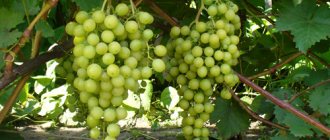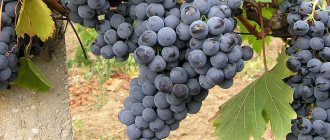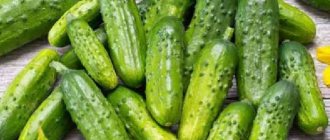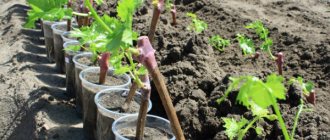Siberia and the northern regions do not have a climate suitable for grapes: summers are hot, there may be a lack of moisture, winters are frosty with thaws and dry winds. But this is not a reason not to grow grapes! Through experience, local agronomists show what harvests are possible and what other ones. But it is important to properly prepare the grapes for wintering. After all, winter hardiness is affected not only by the intensity of frost, but also by the condition of the plant itself: the degree of ripening of the shoots and the adequacy of nutrition of the shoots and roots. We'll tell you how to properly grow grapes in Siberia.
Rule 1. Choose the right variety for the northern regions
To begin with, it is important to choose a variety adapted to the climate of Siberia. It must meet the following conditions:
- Increased winter hardiness and frost resistance.
- The temperature for bud formation is low, t +18…+23 °C.
- Ripening period is early and very early, up to 130 days.
The varieties Bogatyr Kirchika, Madeleine Anzhevin, Aleshenkin, Moskovsky, Shasla Ramminga and Shasla, Violetovy ranniy (increased winter hardiness), Seedless black winter-hardy, Alpha, Muromsky, Zhemchug Saba, Ranni Magaracha (No. 372) and Magarach white (No. 352) meet these criteria. , Anniversary of Novgorod, Frost-resistant Sharova and Siberian winter-hardy Sharova, Award, Palmyra, Festival, Amber Kuzmina, Amur bisexual, Bashkir early, White rose, Lop-eared, Far Eastern Ramminga, Zarya Kuibysheva, Dawn of the North, Corundum, Beauty of the Volga region, Goryanka Vine, Michurinets and Michurinsky.
And also varieties:
- Korinka (Russian, Michurina).
- Muscat (all types: white very early 16-1-23, white very early 7-2-14, black very early, Melnik, Donskoy).
- Northern (white, black, early).
- Seedling (Strelyaeva, Malengra, Chasselas).
- Tambov (early, white, pink, black, green).
- Black (wine, sweet).
- Kuibyshevsky (early, emerald, early ripening, pink).
Important information! Some early and very early grape varieties such as Vostorg, Cardinal, and Koroleva Vineyards are suitable for Siberia in terms of ripening. But for bud formation they need temperatures of +26...+35 °C. They are not always available in Siberia during this period, and such varieties in open ground may not produce a harvest. Therefore, they are grown here only in greenhouses. Pay attention to the temperature of bud formation.
All varieties with a ripening period of more than 125-130 days are not suitable for growing in open ground in Siberia.
Features of the choice of varieties: Lydia, Alpha, Delight, Devichy, Vorontsov
Since the main problem of growing grapes in Siberia is spring and autumn frosts, as well as winter frosts, the variety, first of all, must be frost-resistant. Therefore, preference should be given to species specially bred for this region. Among the varieties of grapes that can tolerate the lowest temperatures, we can distinguish the following types:
- Siberian cherry;
- Alpha;
- Thumbelina;
- Tukay;
- Delight;
- Memory of Dombkowska;
- Muscat.
Delight tolerates frosts down to -25°C without any shelter.
Also in the region you can grow varieties Lydia, Valentina, Atlas, Sibirkovy, Devichy, Vorontsov, Arka, Monarch, White Miracle, Gift to Zaporozhye, Lady's Fingers. The ripening period of the grapes is no less important. In Siberia there is a short period of warm weather, so the berries must be early ripening.
Rule 2: Plant in spring and at the correct depth
Cuttings should be planted in Siberia in the spring, between the 10th and 25th of May, when the soil warms up to +9…+10 °C. Autumn planting is possible only in the southern regions without harsh winters; in Siberia, such seedlings do not have time to take root. The planting depth depends on the freezing depth:
- Asian and European varieties die at soil temperatures of -5...-6 °C.
- Varieties Madeleine Angevin, Riesling, Black Tsimlyansky die at -7...-8 °C.
- US and Canadian varieties die at -9...- 10 °C.
- Michurin varieties Arctic, Buytur, Russian Concord and Amur grape varieties die at -11...-12 °C.
In Siberia, the soil often freezes to a greater depth, so grapes are planted in trenches 30 cm deep, in which planting holes are additionally dug. The bottom of the trench becomes level with the ground surface, and the roots are at a depth of 60-70 cm.
Prevention of diseases and pests of frost-resistant grapes
The harsh climate does not allow pests and diseases to multiply as they do in the southern regions. Gardeners recommend adhering to the following rules for prevention:
- choose varieties that are resistant to pests and diseases;
- burn cut branches and fallen leaves;
- cover the soil under the bushes with ash;
- minimize nitrogen fertilizers;
- avoid overwatering.
For powdery mildew, use “Tiovit”, or prepare a solution of 0.5% potassium permanganate. Healthy plants are sprayed 1 to 3 times. To prevent gray rot, use Euparen and Benomyl.
Rule 4. Prepare grapes for wintering
In Siberia, due to the climate, the dormant period for grapes lasts as long as 7-8 months, from autumn frosts until the end of April. At this time, all metabolic processes take place that require strength and nutrition. If during the growing season the grapes do not accumulate the necessary supply of nutrients, then during the winter they will weaken and may even die in the spring. This is a critical period.
In order for grapes to winter well in Siberia, they are covered as follows:
- After dropping the leaves, spray the grapes with a 50% glycerin solution. This significantly increases the frost resistance of grapes.
- After the first frost, remove the vine from the trellis, trim it and lay it on the bottom of the trench.
- When it gets colder to -5 °C (late September - October), cover the trench with shields.
- Cover the panels with sawdust or hay in a layer of 20 cm.
- Cover with film to prevent it from getting wet.
- Cover the top with a 10 cm layer of soil.
- On the ground - a layer of snow of at least 25 cm!
This way the grapes will overwinter well. In the first year they cover without pruning, even before the first frost - in September.
Recommendations for crop care
You can grow a healthy plant only by following the rules of planting, watering, and thinning. It is necessary to protect the grapes from adverse weather conditions and cover them in winter.
Watering rules
The soil should not dry out. The soil should remain moderately moist. Excess moisture accumulates at the roots, which will begin to rot in such conditions. For grapes, holes and furrows are usually dug for watering. The amount of moisture depends on the weather, time of year and condition of the plant.
Additional watering is required after the buds open, a week or two before flowering, and a couple of weeks after the flowers bloom. Moderately add moisture before preparing for winter. During the flowering period, watering is prohibited. If you take proper care during the indicated periods, you will not need to water the grapes abundantly in August.
Fertilizer application
When preparing the hole, they add enough fertilizer to last the grapes for ten years. But if you haven’t fertilized enough, or weather conditions have become difficult, then additional fertilizing will be required. Minimize the amount of nitrogen-containing fertilizers. In the first year, preference is given to organic fertilizers, mixing them with mineral and potassium-phosphorus fertilizers.
Expert opinion
Stanislav Pavlovich
Gardener with 17 years of experience and our expert
Ask a Question
Important! It is permissible to use both compositions made independently and ready-made mixtures.
The dosage is selected individually. Gardeners take into account the complexity of weather conditions, the age of the plant, and soil characteristics. Fertilize complexly twice, using only liquid fertilizers. If the plant blooms, then fertilizers are not applied.
The importance of mulch
Mulch allows you to retain moisture in the soil and keep the soil loose. It protects the root system of grapes from rot and fungus. The earth maintains a comfortable temperature. Mulch is laid only in spring. The earth should warm up, and rain, snow, and strong winds are not expected in the coming days. Grass, hay, straw or sawdust will do.
Expert opinion
Stanislav Pavlovich
Gardener with 17 years of experience and our expert
Ask a Question
Important! When applying the mulch should not be wet.
When mulch rots, it releases carbon dioxide. Regular addition of elements will improve the survival and fruiting of grapes and preserve natural immunity. Even if the bottom layer rots, the top layer will remain dry.
See also: Grapes burst and rot: causes and methods of treatment
Bush formation
It is not necessary to prune in the first year. It is enough to tie the plant to a trellis, fittings, stake. If a long shoot appears, then it is also tied up. Stepchildren that grow in the summer are pinched. Young vines need increased nutrition. The more leaves, the more active the processes of photosynthesis take place. The formation stages are carried out according to the following scheme:
- in the fall, cut one shoot into 3-4 buds, and the other into 2;
- in the 2nd year in the spring the shoots are tied horizontally and vertically, and in the fall the sleeve of four buds is cut in half;
- in the 3rd year, in the spring, the arrows are tied horizontally, and the summer stepsons are tied vertically, and in the fall, the horizontal branches are cut to a replacement knot.
From the fourth year, the formation of the bush continues according to the same pattern. Pruning is carried out only in dry weather. The sections are treated with garden varnish or a special mixture. The cut parts are burned.
Sheltering grapes for the winter
After harvesting, it is necessary to protect the plant from upcoming frosts. The ground is covered with film, the vines are removed from the supports and laid on the film. Arcs are installed on top and conditions are created, like in a greenhouse. A temporary shelter will protect the grapes from frost, but for the coming winter it is necessary to build a permanent structure.
The grapes need to be covered so that they are in an air gap. The plant should be stored in a box with sides without access to moisture. If water gets in, the vine will rot. The plant itself should not touch metal, arcs or pins. The shelter is removed closer to May and a greenhouse is installed. The vines can be tied up again only after the last frost has passed.
Rule 6. Do the main pruning in the spring
In our case, it is important that the grapes can be bent to the ground and insulated. Therefore, in Siberia, a standard-free fan and semi-fan crown shape is most often used. Pruning is done twice - in autumn and spring. In autumn, fruit-bearing arrows and old, withered shoots are removed. In the spring, the number of shoots and eyes is adjusted, removing excess.
The main pruning is best done in the spring. This method will make it possible to compensate for the loss of frozen shoots by using those that were not removed in the fall, if the grapes have difficulty overwintering.
Rule 7. Be sure to feed
Without fertilizing during the growing season, grapes in Siberia will not survive the winter! The fertilizer schedule is as follows:
- In the fall, when digging, use a bucket of humus and 100 g of nitroammophoska per square meter. meter. Instead of nitroammophoska, you can take 10 g of nitrogen, 20 g of phosphorus, 15 g of potassium sulfate.
- Loose the same mineral fertilizer into the soil 2 weeks before flowering.
- At the very beginning of flowering, spray with a solution of foliar fertilizers to prevent the ovaries from falling off.
- Loosen phosphorus and potassium at the stage of berry ripening.
- Along with watering in July. If these are liquid fertilizers, then you can take 3 tbsp. spoons of nitroammophoska or a solution of 1 tbsp. spoon of urea, 2 tbsp. spoons of superphosphate, 1 tablet of microfertilizers and 2 tablespoons of potassium sulfate per 10 liters of water.
- In mid-August, spray with foliar fertilizer to make the berries sweeter and ripen faster. 15 g of urea, 100 g of superphosphate, 40 g of potassium, a teaspoon of boric acid and 1/3 teaspoon of potassium permanganate per 10 liters of water.
You cannot overload and overfeed the bushes; this also makes them winter worse. From August you need to stop watering, quickly harvest and mint shoots.
Grapes in Siberia / Ya.T. Kirchik. — 3rd ed., rev. and additional - Novosibirsk: NSTU Publishing House, 2013. - 230 e.











